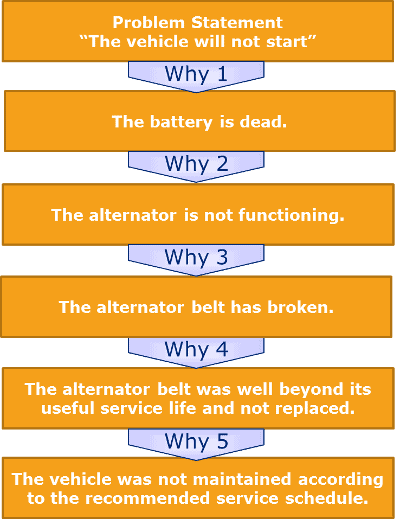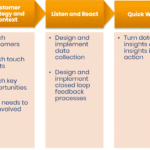Your customer feedback data collection process is going just fine. You’re collecting lots of interesting results, sending reports to your peers and generally feeling good. But there’s a nagging problem: nothing is changing in the business. The scores are not improving, but they are not getting worse either.
Maybe you’ve neglected a key part of the customer feedback process: root cause analysis and action planning.
In a recent piece of research we identified that Finding and Applying Quality System Methods was one of the 6 Key Drivers of Successful Customer Feedback Programs. A common, useful and easy to learn approach to understanding how to drive change in your score is the 5 Whys Process.
What is the 5 Whys Root Cause Analysis Process
For a general review of using quality process in the customer feedback process see this post: Customer Feedback Management Meets Quality Systems
5 Whys is one of the most commonly used quality system tools. It is a simple and methodical way to identify the root cause of an issue. The real value of the process is that it drives you to find and solve the underlying cause of the issue not just the obvious symptom.
By solving the underlying cause you ensure that the problem does not happen again. This prevents you having to solve the symptom (the problem you currently see) in the future; thus saving you time, money and effort every day.
How to Run a 5 Whys Analysis
There are four key steps in the process.
Step 1: Agree on the problem statement
“If I had an hour to save the world, I would spend 59 minutes defining the problem and one minute finding solutions.” – Albert Einstein
Spend some time making sure that you have a good definition of the problem. Don’t skimp on this step because if you have a muddy problem definition you will have a muddy solution.
Step 2: Ask “Why Did This Happen”
Simply determine what happened to cause the problem. Just go one layer at a time here. Don’t try to get too fancy.
Step 3: Check – Is This a Root Cause?
Stop and ask yourself if the Why you just wrote down is the real and underlying root cause of the problem. If it’s not then you have another symptom and you need to go back to Step 2 and ask again.
Repeat Steps 2 and 3 until you have the final and underlying cause of the issue. Typically you will need to ask the Why question about 5 times to get to the root cause. Now you know why it’s called The 5 Whys Process.
It might take fewer or more than five so be prepared to keep going until you get it solved.
Step 4: Fix the underlying cause, and correct the symptom
Now you need to fix both the underlying cause that you have uncovered and the symptom.
You do this not to fix the problem you started with (the symptom) but to prevent the problem from occurring again. This is the real value of the process.
You also need to correct the symptom that started the process in the first place but if you’ve run the process correctly it will be the last time you need to fix it.
5 Whys Example
Below is a simple 5 Whys example. It is simple to follow but it will give you a good idea of how the process works.
Gotchas in the Process
That all sounds easy, and it is, but you need to be careful that you run the process effectively and there are a couple of side tracks that can lead you down the wrong path.
Don’t Relax Too Soon
Firstly, you can be content with the answer too soon. Be careful of giving up too soon and thinking that you have the root cause sorted.
This is the most common failing I see when using this approach. Keep going until you are really certain that what you have is not a symptom but a real root cause.
Stay on Target
Secondly, sometimes you can get yourself into a circular loop whereby at some point your next Why points back to your first problem.
For example:
Sales are down
-> Because we are not processing enough leads
-> Because we don’t have enough sales people
-> Because we laid off sales people
-> Because we had to cut costs
-> Because sales are down.
If this happens you need to be very careful and look closely at each of the symptoms. Make sure that you haven’t just picked the most obvious Why and missed the real Why.
The same analysis could easily look like this:
Sales are down
-> Because we are not processing enough leads
-> Because we have not automated the leads management process
-> Because we have not invested in a CRM
-> Root Cause: We should invest in a CRM that can automate our leads processes.
Keep Following the Scent
Sometimes you will get a point where there are two potential whys. To go back to our example:
Sales are down -> Because we are not processing enough leads
1. -> Because we don’t have enough sales people
2. -> Because we have not automated the leads management process
Here you need to create a new branch for each of the potential Whys. Later on you need to go back and determine which is the highest priority Why. In other words which Why is causing most of the problem so that you can start solving it.
Using 5 Whys in Customer Feedback Teams
Of course you can use a tool like 5 Whys in many ways in the customer feedback process but one of the best is in your weekly meetings where you can apply it to one or two really bad pieces of feedback each week.
Here is what you do:
- Put some time on the weekly staff or group meeting agenda.
- Then at each weekly meeting simply grab some verbatim comments from your lowest scoring responses. If you’re using Net Promoter then grab zeros and ones.
- Frame the comment as a problem statement. You may have to split it into more than one problem statement if there are several ideas in the comment. Just make sure that you have one thought/idea/problem to work with at a time.
- Then have your team run the 5 Whys’ process on the first problem. Aim to get to the end point in 10 or 15 minutes.
- Now, and this is the most important part, assign someone to spend the time between this meeting and the next to validate the analysis that has been done and look for a solution to the root cause.
Your goal here is to make changes to resolve the problem statement quickly. Ideally in the next week or two. If you get to a root cause that can’t be solved quickly move it off to a specific project team.
This process of reviewing customer feedback and making small changes will get you moving and make the larger changes easier to make.
Employees will also feel good that they are solving the problems that customers raise and not just sweeping them under the carpet.










